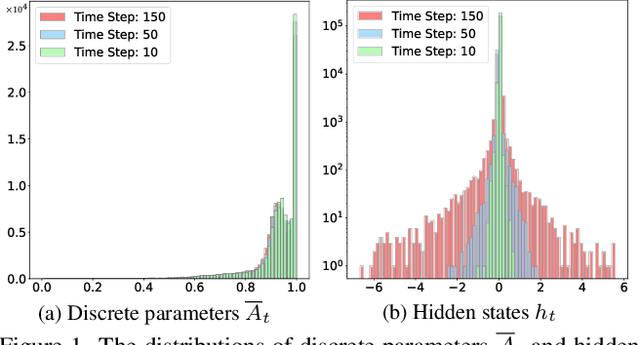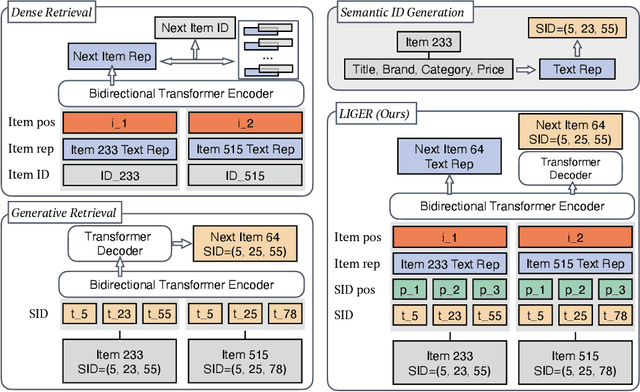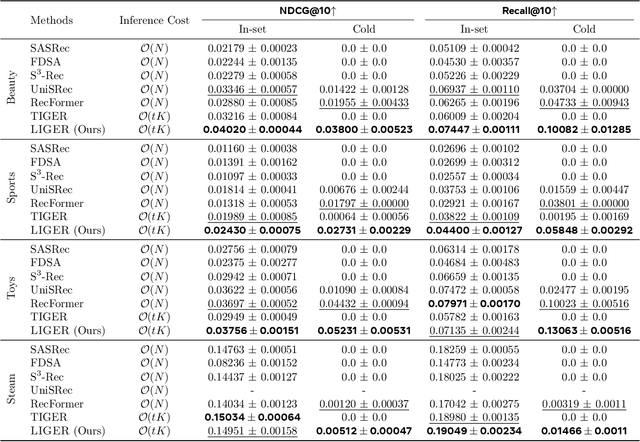Jiacheng Li
In-Loop Filtering Using Learned Look-Up Tables for Video Coding
Sep 11, 2025Abstract:In-loop filtering (ILF) is a key technology in video coding standards to reduce artifacts and enhance visual quality. Recently, neural network-based ILF schemes have achieved remarkable coding gains, emerging as a powerful candidate for next-generation video coding standards. However, the use of deep neural networks (DNN) brings significant computational and time complexity or high demands for dedicated hardware, making it challenging for general use. To address this limitation, we study a practical ILF solution by adopting look-up tables (LUTs). After training a DNN with a restricted reference range for ILF, all possible inputs are traversed, and the output values of the DNN are cached into LUTs. During the coding process, the filtering process is performed by simply retrieving the filtered pixel through locating the input pixels and interpolating between the cached values, instead of relying on heavy inference computations. In this paper, we propose a universal LUT-based ILF framework, termed LUT-ILF++. First, we introduce the cooperation of multiple kinds of filtering LUTs and propose a series of customized indexing mechanisms to enable better filtering reference perception with limited storage consumption. Second, we propose the cross-component indexing mechanism to enable the filtering of different color components jointly. Third, in order to make our solution practical for coding uses, we propose the LUT compaction scheme to enable the LUT pruning, achieving a lower storage cost of the entire solution. The proposed framework is implemented in the VVC reference software. Experimental results show that the proposed framework achieves on average 0.82%/2.97%/1.63% and 0.85%/4.11%/2.06% bitrate reduction for common test sequences, under the AI and RA configurations, respectively. Compared to DNN-based solutions, our proposed solution has much lower time complexity and storage cost.
Any-Step Density Ratio Estimation via Interval-Annealed Secant Alignment
Sep 05, 2025Abstract:Estimating density ratios is a fundamental problem in machine learning, but existing methods often trade off accuracy for efficiency. We propose \textit{Interval-annealed Secant Alignment Density Ratio Estimation (ISA-DRE)}, a framework that enables accurate, any-step estimation without numerical integration. Instead of modeling infinitesimal tangents as in prior methods, ISA-DRE learns a global secant function, defined as the expectation of all tangents over an interval, with provably lower variance, making it more suitable for neural approximation. This is made possible by the \emph{Secant Alignment Identity}, a self-consistency condition that formally connects the secant with its underlying tangent representations. To mitigate instability during early training, we introduce \emph{Contraction Interval Annealing}, a curriculum strategy that gradually expands the alignment interval during training. This process induces a contraction mapping, which improves convergence and training stability. Empirically, ISA-DRE achieves competitive accuracy with significantly fewer function evaluations compared to prior methods, resulting in much faster inference and making it well suited for real-time and interactive applications.
Generating Long Semantic IDs in Parallel for Recommendation
Jun 06, 2025Abstract:Semantic ID-based recommendation models tokenize each item into a small number of discrete tokens that preserve specific semantics, leading to better performance, scalability, and memory efficiency. While recent models adopt a generative approach, they often suffer from inefficient inference due to the reliance on resource-intensive beam search and multiple forward passes through the neural sequence model. As a result, the length of semantic IDs is typically restricted (e.g. to just 4 tokens), limiting their expressiveness. To address these challenges, we propose RPG, a lightweight framework for semantic ID-based recommendation. The key idea is to produce unordered, long semantic IDs, allowing the model to predict all tokens in parallel. We train the model to predict each token independently using a multi-token prediction loss, directly integrating semantics into the learning objective. During inference, we construct a graph connecting similar semantic IDs and guide decoding to avoid generating invalid IDs. Experiments show that scaling up semantic ID length to 64 enables RPG to outperform generative baselines by an average of 12.6% on the NDCG@10, while also improving inference efficiency. Code is available at: https://github.com/facebookresearch/RPG_KDD2025.
Benchmarking the Myopic Trap: Positional Bias in Information Retrieval
May 20, 2025Abstract:This study investigates a specific form of positional bias, termed the Myopic Trap, where retrieval models disproportionately attend to the early parts of documents while overlooking relevant information that appears later. To systematically quantify this phenomenon, we propose a semantics-preserving evaluation framework that repurposes the existing NLP datasets into position-aware retrieval benchmarks. By evaluating the SOTA models of full retrieval pipeline, including BM25, embedding models, ColBERT-style late-interaction models, and reranker models, we offer a broader empirical perspective on positional bias than prior work. Experimental results show that embedding models and ColBERT-style models exhibit significant performance degradation when query-related content is shifted toward later positions, indicating a pronounced head bias. Notably, under the same training configuration, ColBERT-style approach show greater potential for mitigating positional bias compared to the traditional single-vector approach. In contrast, BM25 and reranker models remain largely unaffected by such perturbations, underscoring their robustness to positional bias. Code and data are publicly available at: www.github.com/NovaSearch-Team/RAG-Retrieval.
Dequantified Diffusion Schrödinger Bridge for Density Ratio Estimation
May 08, 2025Abstract:Density ratio estimation is fundamental to tasks involving $f$-divergences, yet existing methods often fail under significantly different distributions or inadequately overlap supports, suffering from the \textit{density-chasm} and the \textit{support-chasm} problems. Additionally, prior approaches yield divergent time scores near boundaries, leading to instability. We propose $\text{D}^3\text{RE}$, a unified framework for robust and efficient density ratio estimation. It introduces the Dequantified Diffusion-Bridge Interpolant (DDBI), which expands support coverage and stabilizes time scores via diffusion bridges and Gaussian dequantization. Building on DDBI, the Dequantified Schr\"odinger-Bridge Interpolant (DSBI) incorporates optimal transport to solve the Schr\"odinger bridge problem, enhancing accuracy and efficiency. Our method offers uniform approximation and bounded time scores in theory, and outperforms baselines empirically in mutual information and density estimation tasks.
Plug-and-Play Versatile Compressed Video Enhancement
Apr 21, 2025Abstract:As a widely adopted technique in data transmission, video compression effectively reduces the size of files, making it possible for real-time cloud computing. However, it comes at the cost of visual quality, posing challenges to the robustness of downstream vision models. In this work, we present a versatile codec-aware enhancement framework that reuses codec information to adaptively enhance videos under different compression settings, assisting various downstream vision tasks without introducing computation bottleneck. Specifically, the proposed codec-aware framework consists of a compression-aware adaptation (CAA) network that employs a hierarchical adaptation mechanism to estimate parameters of the frame-wise enhancement network, namely the bitstream-aware enhancement (BAE) network. The BAE network further leverages temporal and spatial priors embedded in the bitstream to effectively improve the quality of compressed input frames. Extensive experimental results demonstrate the superior quality enhancement performance of our framework over existing enhancement methods, as well as its versatility in assisting multiple downstream tasks on compressed videos as a plug-and-play module. Code and models are available at https://huimin-zeng.github.io/PnP-VCVE/.
All-in-One Image Compression and Restoration
Feb 05, 2025



Abstract:Visual images corrupted by various types and levels of degradations are commonly encountered in practical image compression. However, most existing image compression methods are tailored for clean images, therefore struggling to achieve satisfying results on these images. Joint compression and restoration methods typically focus on a single type of degradation and fail to address a variety of degradations in practice. To this end, we propose a unified framework for all-in-one image compression and restoration, which incorporates the image restoration capability against various degradations into the process of image compression. The key challenges involve distinguishing authentic image content from degradations, and flexibly eliminating various degradations without prior knowledge. Specifically, the proposed framework approaches these challenges from two perspectives: i.e., content information aggregation, and degradation representation aggregation. Extensive experiments demonstrate the following merits of our model: 1) superior rate-distortion (RD) performance on various degraded inputs while preserving the performance on clean data; 2) strong generalization ability to real-world and unseen scenarios; 3) higher computing efficiency over compared methods. Our code is available at https://github.com/ZeldaM1/All-in-one.
QMamba: Post-Training Quantization for Vision State Space Models
Jan 23, 2025



Abstract:State Space Models (SSMs), as key components of Mamaba, have gained increasing attention for vision models recently, thanks to their efficient long sequence modeling capability. Given the computational cost of deploying SSMs on resource-limited edge devices, Post-Training Quantization (PTQ) is a technique with the potential for efficient deployment of SSMs. In this work, we propose QMamba, one of the first PTQ frameworks to our knowledge, designed for vision SSMs based on the analysis of the activation distributions in SSMs. We reveal that the distribution of discrete parameters exhibits long-tailed skewness and the distribution of the hidden state sequence exhibits highly dynamic variations. Correspondingly, we design Long-tailed Skewness Quantization (LtSQ) to quantize discrete parameters and Temporal Group Quantization (TGQ) to quantize hidden states, which reduces the quantization errors. Extensive experiments demonstrate that QMamba outperforms advanced PTQ methods on vision models across multiple model sizes and architectures. Notably, QMamba surpasses existing methods by 21.0% on ImageNet classification with 4-bit activations.
Preference Discerning with LLM-Enhanced Generative Retrieval
Dec 11, 2024



Abstract:Sequential recommendation systems aim to provide personalized recommendations for users based on their interaction history. To achieve this, they often incorporate auxiliary information, such as textual descriptions of items and auxiliary tasks, like predicting user preferences and intent. Despite numerous efforts to enhance these models, they still suffer from limited personalization. To address this issue, we propose a new paradigm, which we term preference discerning. In preference dscerning, we explicitly condition a generative sequential recommendation system on user preferences within its context. To this end, we generate user preferences using Large Language Models (LLMs) based on user reviews and item-specific data. To evaluate preference discerning capabilities of sequential recommendation systems, we introduce a novel benchmark that provides a holistic evaluation across various scenarios, including preference steering and sentiment following. We assess current state-of-the-art methods using our benchmark and show that they struggle to accurately discern user preferences. Therefore, we propose a new method named Mender ($\textbf{M}$ultimodal Prefer$\textbf{en}$ce $\textbf{d}$iscern$\textbf{er}$), which improves upon existing methods and achieves state-of-the-art performance on our benchmark. Our results show that Mender can be effectively guided by human preferences even though they have not been observed during training, paving the way toward more personalized sequential recommendation systems. We will open-source the code and benchmarks upon publication.
Unifying Generative and Dense Retrieval for Sequential Recommendation
Nov 27, 2024



Abstract:Sequential dense retrieval models utilize advanced sequence learning techniques to compute item and user representations, which are then used to rank relevant items for a user through inner product computation between the user and all item representations. However, this approach requires storing a unique representation for each item, resulting in significant memory requirements as the number of items grow. In contrast, the recently proposed generative retrieval paradigm offers a promising alternative by directly predicting item indices using a generative model trained on semantic IDs that encapsulate items' semantic information. Despite its potential for large-scale applications, a comprehensive comparison between generative retrieval and sequential dense retrieval under fair conditions is still lacking, leaving open questions regarding performance, and computation trade-offs. To address this, we compare these two approaches under controlled conditions on academic benchmarks and propose LIGER (LeveragIng dense retrieval for GEnerative Retrieval), a hybrid model that combines the strengths of these two widely used methods. LIGER integrates sequential dense retrieval into generative retrieval, mitigating performance differences and enhancing cold-start item recommendation in the datasets evaluated. This hybrid approach provides insights into the trade-offs between these approaches and demonstrates improvements in efficiency and effectiveness for recommendation systems in small-scale benchmarks.
 Add to Chrome
Add to Chrome Add to Firefox
Add to Firefox Add to Edge
Add to Edge